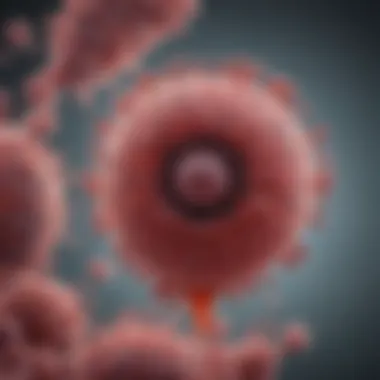Understanding Staphylococcus in Urinary Tract Infections


Intro
Urinary tract infections (UTIs) are a widespread concern, affecting millions of individuals globally. Among various bacterial agents, Staphylococcus species have emerged as relevant players in this context. Often overlooked, these bacteria can indicate deeper health issues when detected in urine. Understanding their characteristics and implications for urinary tract health is paramount.
This article explores the role Staphylococcus plays in UTIs by examining individual species, their resistance patterns, and the diagnostic methodologies employed in identifying these infections. It aims to inform health professionals and researchers about the practical implications of Staphylococcus in urinary health, considering both the epidemiological trends and therapeutic approaches.
Research Overview
Methodological Approaches
Several methodological techniques are employed to study the presence and impact of Staphylococcus in urinary tract infections. Microbial culture remains a core method, allowing for the isolation and identification of bacterial species from urine samples. Recent advancements also incorporate molecular techniques, such as PCR, to detect bacterial DNA directly, increasing sensitivity and specificity.
Analyzing antibiotic susceptibility through standardized tests enables practitioners to understand resistance patterns. This information is crucial as many Staphylococcus species exhibit increasing resistance to common antibiotics, including methicillin, which complicates treatment options.
Significance and Implications
The presence of Staphylococcus in urine is significant for several reasons. Firstly, it can signal an underlying infection that may require immediate attention. Secondly, the identification of specific species, such as Staphylococcus saprophyticus, which is known for causing UTIs, can guide treatment decisions. Understanding the resistance mechanisms of these bacteria is essential for developing effective therapeutic strategies.
Monitoring the trends in antibiotic resistance is imperative. An increase in resistance among Staphylococcus species not only limits treatment options but also poses a threat to public health by leading to more complicated infections.
"Understanding the resistance patterns of Staphylococcus in UTIs is crucial for effective patient management and antibiotic stewardship."
Current Trends in Science
Innovative Techniques and Tools
Emerging technologies are revolutionizing the way Staphylococcus infections are studied and managed. For example, rapid diagnostic tools that leverage next-generation sequencing can provide a comprehensive view of the microbial population in urine samples. This approach helps identify not just Staphylococcus species but also other co-infecting organisms.
The integration of artificial intelligence in analyzing data from laboratory tests enhances the prediction of infection outcomes. These innovations facilitate tailored treatments based on individual patient profiles, potentially improving overall efficacy.
Interdisciplinary Connections
The exploration of Staphylococcus in urinary tract infections spans multiple disciplines. Microbiology, medicine, epidemiology, and pharmacology all intersect in this area. By collaborating across these fields, researchers can gain a holistic understanding of bacterial behavior, pathogenesis, and treatment response.
Prolusion to Staphylococcus
The study of Staphylococcus, a genus of bacteria, plays a significant role in understanding urinary tract infections (UTIs). Knowing how these bacteria operate and their classification helps in diagnosing and treating related ailments efficiently. Frequent occurrences of UTIs can indicate underlying health issues. Hence, the aim of this section is to provide insights into Staphylococcus, focusing on its characteristics, classification, and relevance to urinary tract health.
Overview of Staphylococcus Bacteria
Staphylococcus bacteria are a group of spherical-shaped bacteria, known as cocci, characterized by their clusters that resemble bunches of grapes when viewed under a microscope. These organisms are Gram-positive, which means they retain the violet stain used in the Gram staining procedure. Staphylococcus comprises multiple species, but the most significant relate to human health include Staphylococcus aureus and Staphylococcus epidermidis.
Staphylococcus aureus is often seen as a pathogen, responsible for a wide range of infections, including skin infections, pneumonia, and UTIs. Its capacity to withstand unfavorable conditions and its virulence make it a notable organism in clinical microbiology. Meanwhile, Staphylococcus epidermidis, typically part of the human flora, can turn pathogenic under certain conditions, especially in immunocompromised individuals.
Understanding the basic attributes of these bacteria provides critical insights into their behavior within the urinary tract, notably how they can lead to infections. The potential for these bacteria to contribute to complicated and recurrent UTIs calls for a thorough study of their biological and biochemical characteristics.
Classification of Staphylococcus
The classification of Staphylococcus primarily divides these organisms into two major categories: coagulase-positive and coagulase-negative staphylococci.
- Coagulase-Positive Staphylococci:
- Coagulase-Negative Staphylococci:
- Staphylococcus aureus is the primary member of this group. It is significant in clinical settings due to its pathogenicity. The ability to clot blood plasma using the enzyme coagulase assists in differentiating it from other species.
- This group includes species like Staphylococcus epidermidis, Staphylococcus saprophyticus, and others. They are generally less virulent but can cause infections, particularly in patients with implanted devices or weakened immune systems.
In summary, the classification of Staphylococcus assists in identifying the specific type of infection, guiding the choice of treatment. The distinction between coagulase-positive and coagulase-negative forms is vital for clinicians when addressing possible UTIs, enabling tailored therapeutic interventions suited to the patient's needs.


"Knowledge of Staphylococcus classification enhances our capability to diagnose and treat urinary tract infections effectively."
By understanding the unique features and classifications of Staphylococcus, we equip healthcare professionals with the tools necessary to recognize and address the implications these bacteria have on urinary health.
Staph in Urine: An Overview
Staphylococcus species are increasingly recognized as significant contributors to urinary tract infections (UTIs). This section elucidates the importance of Staphylococcus in urine, focusing on the potential complications arising from its presence. Understanding the role of this bacterium in urinary health is essential for students, researchers, and healthcare professionals alike.
When Staphylococcus bacteria are found in urine, it may be indicative of a UTI or other health issues. This underscores the need for precise diagnosis and appropriate treatment. UTIs caused by Staphylococcus can lead to severe complications if not correctly managed, as they can affect not only the urinary system but also potentially impact kidney function. Thus, it is essential to grasp the full scope of this bacterium’s involvement in urinary tract health.
Understanding Urinary Tract Infections
A urinary tract infection occurs when bacteria invade the urinary system, which includes the kidneys, ureters, bladder, and urethra. UTIs manifest primarily in two forms: cystitis, affecting the bladder, and pyelonephritis, impacting the kidneys. Symptoms of a UTI generally encompass a frequent urge to urinate, painful urination, and lower abdominal pain.
Numerous factors can contribute to the development of UTIs. Poor hygiene practices, residual urine in the bladder, and indeed the presence of certain bacteria greatly influence the onset of an infection. It is vital to acknowledge that while E. coli remains the most common bacteria found in UTIs, Staphylococcus can also play a notable role in certain cases.
Role of Staphylococcus in UTIs
Staphylococcus species, particularly Staphylococcus saprophyticus, are noted for their involvement in urinary tract infections. This bacterium is considered a common uropathogen, especially among young women. The pathogenicity of Staphylococcus in UTIs is often linked to its capacity to adhere to the uroepithelium, which enables it to colonize and establish infection.
Notably, the mechanism of pathogenicity may vary among species. For instance, when Staphylococcus aureus enters the urinary tract, it can jeopardize the integrity of the mucosal barrier, thus exacerbating the infection.
Staphylococcus infections can have implications beyond mere discomfort. If untreated, they pose severe risks, such as the potential for kidney infections, systemic infections, or the onset of sepsis in chronic cases. Therefore, it is crucial to pay close attention to the symptoms and seek medical intervention for suspected UTIs.
Understanding the dynamics of Staphylococcus in urinary tract infections not only facilitates better patient outcomes but also enhances our overall comprehension of microbiological interactions within the human body.
In summary, recognizing Staphylococcus's role within UTIs is imperative for effective diagnosis and treatment. Knowledge in this area assists clinicians in making informed decisions regarding patient care, ultimately leading to better management of urinary tract infections.
Clinical Significance of Staphylococcus in Urine
The importance of understanding Staphylococcus in urine cannot be overstated. These bacteria, often thought of as mere bystanders in urinary tract infections (UTIs), can actually play complex roles. Their presence in urine can indicate not only UTIs but also other serious health problems. Recognizing the clinical significance of Staphylococcus aids in effective diagnosis and treatment. It ensures that healthcare providers can differentiate between various pathogens and choose the correct antibiotics.
Symptoms of Staphylococcal UTIs
Identifying the symptoms associated with Staphylococcal UTIs is crucial for prompt treatment. Patients may experience uncomfortable signs. Common symptoms include:
- Frequent urination
- Painful urination (dysuria)
- Cloudy or dark urine
- Foul-smelling urine
- Lower abdominal pain
In some cases, fever and chills may indicate a more serious infection. Recognizing these symptoms early improves the possibility of a swift and effective response. Furthermore, understanding that these symptoms can also overlap with other types of UTIs highlights the need for comprehensive testing.
Complications Associated with Staph Infections
Staphylococcus infections can lead to a range of complications if left untreated. One significant risk is the potential for the infection to spread beyond the urinary tract.
Some common complications include:
- Pyelonephritis: A severe kidney infection that may result from bacteria traveling up the urinary tract. It can cause kidney damage and may require hospitalization.
- Sepsis: A life-threatening condition that occurs when the body's response to infection leads to systemic inflammation. This can happen as the bacteria enter the bloodstream.
- Recurrent UTIs: Persistent infections can lead to chronic conditions and may require long-term management strategies.
"Recognizing complications early can significantly improve patient outcomes."
Awareness and education about these potential complications empower both patients and healthcare providers. This understanding informs treatment decisions and preventive strategies to minimize health risks.
Diagnosis of Staphylococcus in Urine
Diagnosis of Staphylococcus in urine is a crucial component in managing urinary tract infections (UTIs). It enables healthcare providers to identify the presence of Staphylococcus bacteria accurately. Early and precise diagnosis aids in prompt treatment, which is necessary to prevent complications. The diagnosis process incorporates laboratory tests and cultures, followed by a thorough analysis of results.
Timely detection not only improves patient outcomes but also helps in reducing the risk of chronic infections. Furthermore, understanding the type of Staphylococcus involved allows for appropriate treatment choices, especially in the context of increasing antibiotic resistance.


In summary, accurate diagnosis is foundational in the journey of addressing the impacts of Staphylococcus in urinary health.
Laboratory Tests and Cultures
Laboratory tests play a vital role in diagnosing Staphylococcus in urine. The most common method is a urine culture. During this process, urine specimens are collected and cultured in a lab to identify bacterial growth. Key steps include:
- Specimen Collection: Proper technique is essential for accurate results. Midstream clean-catch urine is typically recommended to minimize contamination.
- Culturing the Sample: The urine is placed on culture media suitable for Staphylococcus growth. Common media include blood agar and selective agars like mannitol salt agar.
- Incubation: The sample is then incubated under specific conditions to encourage bacterial growth.
- Isolation of Bacteria: Follow-up identification is done to isolate the Staphylococcus colonies. This process might involve additional testing to establish the specific species present, such as Staphylococcus aureus or Staphylococcus saprophyticus.
These tests allow practitioners to assess not only the presence of bacteria but also their potential pathogenicity. It is essential to ensure the accuracy of these tests to guide effective treatment.
Interpreting Test Results
Interpreting the results of laboratory tests is a critical skill for healthcare providers managing Staphylococcus UTIs. Upon completion of culturing, results may be reported as:
- Positive Culture: Indicates presence of Staphylococcus.
- Negative Culture: No significant growth detected.
- Mixed Growth: Presence of multiple types of bacteria, which can complicate the diagnosis.
If Staphylococcus is detected, further analysis is required to:
- Determine Species: Knowing whether the bacteria is Staphylococcus aureus or another species can influence treatment options.
- Antibiotic Sensitivity Testing: This is important for guiding appropriate antibiotic therapy. Results can identify which antibiotics are effective against the detected strain.
Understanding these results helps healthcare providers formulate an effective treatment plan tailored to the patient's specific infection. Accurate interpretation is key for optimizing care and reducing the risk of antibiotic resistance, ultimately benefiting the patient’s health outcomes.
"Efficient diagnosis and interpretation of test results are critical in combatting the evolving challenges posed by Staphylococcus in urinary tract health."
By mastering the diagnosis of Staphylococcus in urine, practitioners can navigate the complexities of UTIs with greater precision.
Treating Staphylococcal UTIs
Treating Staphylococcal urinary tract infections is a critical aspect of managing patients’ health. Staphylococcus species can cause significant discomfort and complications, so understanding treatment options is vital. The effectiveness of treatments largely depends on early diagnosis and the specific bacterial strain involved. Prompt intervention can prevent more severe outcomes, including kidney damage or recurrent infections.
Antibiotic Therapy
Antibiotic therapy is the cornerstone for treating Staphylococcal UTIs. Commonly prescribed antibiotics include methicillin, cloxacillin, and vancomycin. The specific choice depends on the susceptibility pattern of the bacteria.
- Initial Treatment: Often, doctors start treatment empirically based on common pathogens expected in UTIs. Once the laboratory test results are available, therapy can be adjusted.
- Duration: The duration of antibiotic treatment usually spans from 7 to 14 days but may vary based on clinical response and culture results. Monitoring the patient’s response is essential to determine if further intervention is needed.
- Resistance Issues: As resistance to antibiotics evolves, it’s crucial for healthcare providers to be aware of local resistance patterns. This understanding guides more effective antibiotic selection.
"Antibiotic resistance in Staphylococcus can complicate treatment. Knowing resistance patterns helps optimize therapy."
Effective management of Staphylococcal UTIs requires careful selection of antibiotics to ensure that the chosen therapy is appropriate for the specific strain.
Challenges in Treatment
While antibiotic therapy is effective, several challenges can hinder successful treatment.
- Antibiotic Resistance: Increasing rates of antibiotic resistance among Staphylococcus species, particularly among methicillin-resistant Staphylococcus aureus (MRSA), presents a growing hurdle in treatment. This resistance results in limited options for effective therapy.
- Recurrent Infections: Some patients may experience recurrent UTIs, which complicates management. Identifying underlying causes, such as structural abnormalities or other health conditions, is key.
- Patient Compliance: Ensuring patients complete the prescribed antibiotic course is another challenge. Non-compliance can lead to treatment failures and further resistance.
- Monitoring and Follow-Up: Regular follow-up is essential to evaluate treatment progress and address any emerging complications. This close monitoring can help adapt treatment plans as needed.
In summary, treating Staphylococcal UTIs necessitates a comprehensive approach that includes appropriate antibiotic therapy and consideration of potential challenges. Recognizing and addressing these challenges can enhance treatment outcomes and contribute to better management of urinary tract health.
Antibiotic Resistance in Staphylococcus
Antibiotic resistance in Staphylococcus is a crucial topic within the context of urinary tract infections (UTIs). Resistance mechanisms not only complicate treatment plans but also increase the morbidity associated with infections. Thus, understanding the factors contributing to this resistance is necessary for effective management of staphylococcal UTIs. The rise of antibiotic-resistant strains of Staphylococcus, particularly Staphylococcus aureus, poses significant challenges for healthcare professionals.
Understanding Resistance Mechanisms
Staphylococcus bacteria have developed several strategies that confer resistance to antibiotics. The most common mechanisms include:
- Enzymatic degradation: Certain strains can produce beta-lactamases, enzymes that break down penicillin and other beta-lactam antibiotics, rendering them ineffective.
- Alteration of target sites: Antibiotic molecules often target specific sites on bacterial cell structures. Mutations in these sites can prevent antibiotics from binding effectively. For example, Methicillin-resistant Staphylococcus aureus (MRSA) alters the penicillin-binding proteins, causing resistance to methicillin and related antibiotics.
- Efflux pumps: Some bacteria employ efflux pumps to expel antibiotics before they can exert their effects. This mechanism actively transports drugs out of the bacterial cell, reducing their intracellular concentrations to sub-lethal levels.


These mechanisms allow Staphylococcus to survive in the presence of antibiotics, complicating treatment options and often leading to prolonged illness.
Impact of Resistance on Treatment Options
The increasing prevalence of antibiotic resistance affects treatment strategies for UTIs caused by Staphylococcus. When standard antibiotics fail, healthcare providers must consider alternative therapies, which may include:
- Combination therapy: Using multiple antibiotics may enhance efficacy and reduce the likelihood of resistance development.
- Use of newer agents: Antibiotics such as linezolid or daptomycin may be used against resistant strains, though they can be more expensive and usually require careful monitoring.
- Increased medication costs: Newer antibiotics are often more costly than traditional ones, impacting healthcare budgets and patient access.
Moreover, the presence of resistant Staphylococcus can lead to longer hospital stays and increased treatment costs due to complications. Resistance also raises concerns regarding the effectiveness of prophylactic measures in high-risk groups.
"Understanding antibiotic resistance is vital for developing effective strategies for managing staphylococcal infections."
Preventive Strategies for Staphylococcal Infections
Preventive strategies are essential in managing Staphylococcus infections, particularly in urinary tract infections. Effective measures not only reduce the incidence of these infections, but also promote overall health in high-risk individuals. The following sections explore several key aspects of prevention that can significantly impact patient outcomes.
Hygiene Practices
Practicing good hygiene is vital in preventing Staphylococcus infections. Simple, consistent actions can create a barrier against bacteria, including those that cause urinary tract infections.
- Hand Hygiene: Regularly washing hands with soap and water is fundamental. This practice is especially crucial before and after using the restroom. If soap and water are not available, hand sanitizers containing at least 60% alcohol can be effective as well.
- Clean Genital Area: Maintaining cleanliness in the genital area can decrease bacterial colonization. Individuals should wash the area with mild soap and water daily. After using the restroom, wiping from front to back can help prevent bacteria from the anal region from entering the urinary tract.
- Safe Sexual Practices: Using condoms and ensuring monogamous relationships can limit the spread of bacterial infections. Additionally, urinating before and after sexual activity can help flush out bacteria from the urethra, reducing the risk of infection.
- Avoiding Irritants: Products such as douches and feminine sprays can disrupt the natural flora of the vagina, increasing susceptibility to infections. It is advisable to avoid these substances.
- Regular Cleaning of Surfaces: For individuals in communal living situations, regularly disinfecting shared bathrooms and surfaces can limit bacterial spread. Effective disinfection practices include using bleach solutions or specialized antibacterial cleaners.
"Preventive measures in effective hygiene can significantly reduce urinary tract infections associated with Staphylococcus."
Identifying High-Risk Groups
Identifying high-risk groups is an important aspect of preventing Staphylococcal infections. Certain populations display a higher vulnerability to developing urinary tract infections, and targeted strategies can help protect these individuals.
- Elderly Individuals: Age-related changes in the urinary tract and decreased immune function make older adults more susceptible to infections. Tailored hygiene and monitoring strategies can greatly benefit this demographic.
- Women: Women are more prone to urinary tract infections due to anatomical differences. Preventive measures should focus on educating women about proper hygiene practices and promoting hydration to help flush bacteria from the urinary system.
- Individuals with Catheters: Catheter use increases the risk of bacterial colonization. Regular care, such as proper catheter management and timely replacement, is integral in preventing infections in these patients.
- Immunocompromised Patients: Those with weakened immune systems, like cancer patients or people with chronic illnesses, require careful monitoring and education regarding personal hygiene and infection risks.
- Diabetics: High blood sugar environments can promote bacterial growth, increasing the likelihood of infections. Diabetics should focus on controlling their blood sugar levels and following strict hygiene protocols.
By recognizing high-risk groups, healthcare providers can implement specific educational programs and preventive strategies tailored to the needs of these populations. This would ultimately lead to more effective management of Staphylococcus infections in urinary tracts.
Future Directions in Research
The examination of Staphylococcus in urinary tract infections is an evolving field of study, which is essential for understanding the complex nature of these bacterial interactions with human health. Ongoing research efforts aim to improve diagnostic techniques, identify novel treatments, and develop effective preventive strategies. As antibiotic resistance rates rise, finding innovative methods to combat these infections becomes increasingly critical.
Emerging Technologies in Diagnosis
Recent advancements in diagnostic technologies have the potential to significantly enhance the accuracy and speed of identifying Staphylococcus in patient samples. One notable method is polymerase chain reaction (PCR), which allows for the rapid detection of bacterial DNA in urine samples. This technique not only shortens the time for diagnosis but also increases specificity, reducing the likelihood of false negatives.
In addition, next-generation sequencing (NGS) is becoming more accessible, permitting a deeper understanding of the genetic makeup of Staphylococcus strains. This technology provides insights into virulence factors and potential antibiotic resistance genes, facilitating targeted treatment decisions. New point-of-care testing devices are also under development, enabling healthcare professionals to get results in clinical settings quickly. The integration of these technologies can streamline the diagnostic process, ultimately improving patient outcomes.
Innovative Treatment Approaches
The treatment landscape for Staphylococcal urinary tract infections is shifting due to rising antibiotic resistance. Researchers are focusing on alternative therapeutic approaches, such as bacteriophage therapy, which utilizes viruses that specifically infect bacteria. This method offers a targeted strategy that can potentially overcome antibiotic resistance.
Furthermore, immunotherapy is gaining traction as a promising avenue. By enhancing the body’s immune response to infections, patients may experience better outcomes and reduced recurrence of UTIs.
The development of new antibiotics is also necessary. Traditional antibiotics are losing their effectiveness, driving research into novel compounds or combination therapies designed to overcome resistant strains of Staphylococcus. There is great potential for effective treatments that do not mimic existing antibiotics but rather utilize different mechanisms of action.
“Innovative research directions are crucial to keep pace with the evolving challenges posed by Staphylococcus in urinary tract infections.”
Ending
The inclusion of Staphylococcus species in the examination of urinary tract health is paramount. Various strains of Staphylococcus, notably Staphylococcus saprophyticus, play a distinct role in UTIs, particularly among young females. This relationship underscores the need for awareness in identifying symptoms and understanding treatment options,
There are clear benefits in recognizing potential infections early. Rapid diagnosis leads to effective management, limiting complications such as recurrent infections or antibiotic resistance. This understanding allows healthcare professionals to tailor treatment strategies. Incorporating current research into clinical guidelines is also a step towards improving patient outcomes.
Considerations about Conclusion
The conclusion also prompts the necessity for ongoing research. The field of microbiology is constantly evolving and recognizing the impact of Staphylococcus in UTIs is critical. As antibiotic resistance becomes a severe issue, understanding not only how these bacteria behave but also how we can combat them is crucial. With advances in technologies and innovative treatment approaches, future studies could yield better diagnostic methods and more effective therapies.
"The complexity of Staphylococcus infections necessitates a multifaceted approach encompassing prevention, proper diagnosis, and innovative treatments."
As we finalize this discussion, it is clear that ongoing dialogue and research on Staphylococcus and its implications for urinary tract infections will enhance not just academic knowledge, but also clinical practices that ultimately benefit patients.



